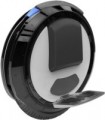Max. load
The maximum rider weight that the device can support (including the weight of a backpack, bag and other things carried on oneself; this is especially important to remember if the weight of the person himself is close to the maximum allowable). If the permissible load is exceeded, the transport not only loses efficiency but can also break down at any time. Therefore, it is impossible to ignore the prescriptions for weight anyway.
Range
The average distance that can be driven on a single battery charge. Usually, the range is indicated with some overestimation — based on a low (optimal from the point of view of energy consumption) speed, uniform movement on a flat surface, etc. Therefore, the actual battery life may be somewhat less. Nevertheless, this parameter is quite suitable for comparing different models with each other.
Thanks to the development of technology, the range in modern self-balancing vehicles can reach
several tens of kilometers.
Max. speed
The maximum speed that the hoverboard is capable of reaching: on a flat surface, with a full battery charge and an average rider weight. The same parameter is also the maximum safe speed allowed when using this model; in theory, it is possible to accelerate even faster (for example, from a mountain), but this is fraught with breakdown, accident and injury, and therefore is not recommended at all.
Most modern models have a maximum speed of up to 20 km/h, and in “high-speed” vehicles this figure can exceed 30 km/h. Note that a fall from a hoverboard, even at a speed of 10 – 15 km/h, is fraught with serious injuries. Therefore, protective gear is highly recommended.
Wheel size
The diameter of the wheels used in the vehicle. Technically,
larger wheels contribute to rolling ability and reduce sensitivity to obstacles and small bumps. However, these possibilities are influenced by many other factors, not least the engine power: with a weak engine, the unit may not have time to cope with the obstacle, which will lead to the rider falling forward. Therefore, large wheels must be combined with a powerful engine.
By itself, information about the diameter of the wheel can be useful when repairing or replacing it.
Max. climb angle
The maximum angle of inclination of the surface at which the vehicle can normally drive up or down (in some models, this parameter is indicated only for one direction, for example, up).
This parameter characterizes the ability of the device to overcome ups and downs. In modern models, it can reach 45 °. At the same time, note that the ability to cope with large angles requires not only powerful motors, but also appropriate design features (in particular, so that the protective cover does not scrape the ground); and for the descent, the second is even more important than the first. Therefore, when choosing a model for frequent driving on slopes, you should pay attention not only to power, but also to the angle of inclination directly stated in the specs.
Also note that at a high load (approaching the maximum), the efficiency of overcoming climbs may decrease. On the other hand, some manufacturers indicate the angle of inclination at the maximum load, and clarify that the light weight of the rider allows you to overcome steeper climbs than originally stated.
Battery capacity
The battery capacity of the device in watt-hours (Wh).
In general, capacity shows the amount of energy that a battery can store. The higher the number, the more energy the battery stores, respectively, the greater the range (see above) and the more time it will take to charge. Note that although watt-hours are used to designate power much less frequently than milliamp-hours (see above), this designation is more reliable, because when evaluating capacity, in this case, the battery voltage is also taken into account (as opposed to counting in mAh). This makes it easy to compare batteries of different voltages. At the same time, do not forget that the energy consumption of different models can also be different, and battery life is easier to evaluate by the directly claimed range.
Power
The power of the motor installed in the device. For models with two electric motors, this paragraph usually indicates their total power.
This parameter is one of the most critical for self-balancing transport. On the one hand, powerful motors improve the efficiency of balancing (especially with the large weight of the rider), allow you to reach high speed, effectively overcome bumps in the road and climb hills. On the other hand, they weigh a lot, are expensive and require capacious batteries to ensure a decent range (which further affects the weight and price of the entire unit). Therefore, motor power, usually, directly depends on the price category of a particular model.
In fact, the more powerful the motors, the better, and the question of choice for this parameter depends primarily on the price.
Number of motors
The number of motors installed in the vehicle.
This parameter is related exclusively to the type of transport (see above): hoverboards require two motors (one per wheel), otherwise, it would be extremely difficult to ensure normal handling, but in
e-unicycles, on the contrary, it makes no sense to install more than one motor.
Full charge time
The time required to fully charge the battery from zero to full capacity. This parameter allows you to estimate how long the breaks should be for a full replenishment of the energy supply. Reducing the charging time makes the use of the device more convenient, but it is achieved through special technologies, which, usually, are not cheap.

